The first-ever World Humanitarian Summit was held this week. It brought together charities, international organisations and world leaders from 175 countries to discuss how we can better deal with the global crises we face today.
At this moment 125 million people worldwide are in need of humanitarian assistance; each year natural disasters kill around 90,000 people and over a fifth of the world's population live in conflict affected countries. One in 122 people is either a refugee, internally displaced, or seeking asylum. If this were the population of a country, it would be the world's 24th biggest.
The Red Cross Red Crescent Movement has 17 million volunteers worldwide. This means that the British Red Cross is part of the largest humanitarian network in the world, uniquely placed to deal with these crises. Local volunteers are often the first on the scene - sometimes long before international actors can gain access. They perform first aid, evacuate buildings, drive ambulances, brave flood waters and provide comfort to those in crisis. They are also at greatest risk. In Syria alone, 61 Red Crescent staff and volunteers have lost their lives since 2011.
I was at the summit to call for a greater focus on local response and I welcome the announcement of the Grand Bargain, a package of reforms to humanitarian funding. The bargain represents a commitment for local NGOs to receive 25% of international humanitarian funding by 2020.
This should not be underestimated. It is a key step in ensuring that we refuse to ignore people in crisis and invest in those that risk their lives every day.
Let's meet some of them...
Philippines: Typhoon Haiyan, November 2013
•Sustained winds of 147mph and gusts of 171mph
•6,300 people died
•1.2 million homes destroyed or damaged
•4 million people left homeless
•16 million people affected
Volunteer: Lenita Macavinta-Diego (49), Philippine Red Cross
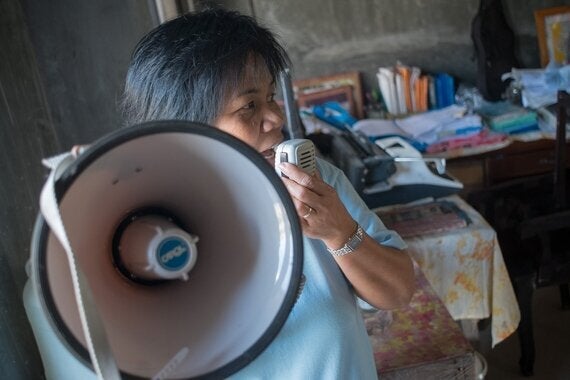
Jarkko Mikkonen; FinnishRedCross
When the strongest typhoon ever to make landfall hit the tiny town of Aliputos on Panay island, local Red Cross volunteer Lenita grabbed her megaphone and got to work.
After Typhoon Frank, which tore her home apart in 2008, Lenita received shelter aid from the Red Cross and became a volunteer. During Typhoon Haiyan Lenita made house to house announcements, making sure the most vulnerable and those in low lying areas were evacuated.
"We don't want any casualties", says Lenita.
Aliputos has 571 households, 110 were totally destroyed while the rest were all damaged. Yet not one human life was lost.
Democratic Republic of Congo: Internal conflict, since 1998
•7 million people in need of assistance
•2 million people internally displaced
•4.8 million food insecure
•Half a million refugees in neighbouring countries
Volunteer: Lakulu Nkwewa Violette, (47) DRC Red Cross
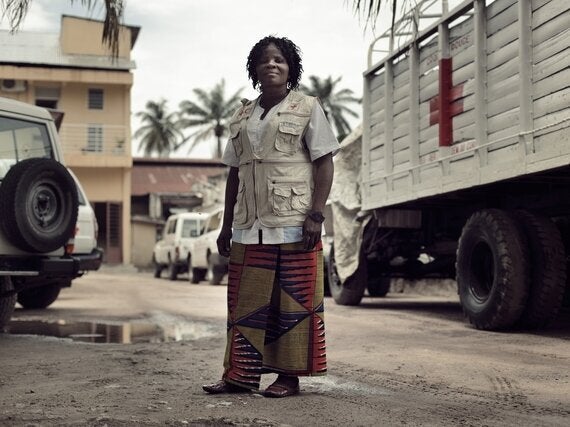
Aapo Huhta; IFRC
The ongoing conflict in DRC continues to cause massive population displacement.
Ever since Lakulu was a young girl, she was inspired by her older brother's volunteering with the Red Cross. She joined as a junior volunteer at the age of 11 and trained in basic emergency response. Lakulu is now a national trainer and coordinator of the women's brigade for the city-province of Kinshasa.
"Some people were surprised that a woman could serve as a rescue volunteer, but I always told them that volunteering or rescuing was not restricted to men."
Haiti: Earthquake, January 2010
•7.0 magnitude earthquake
•220,000 people died
•1.5 million people left homeless
•3.5 million people affected
•4,000 schools damaged or destroyed
Volunteer: Ralph Toussaint, Haiti Red Cross
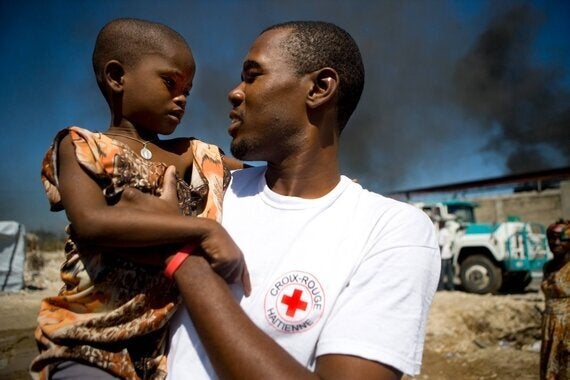
Talia Frenkel; American Red Cross
When the earthquake struck, thousands of Haitian Red Cross volunteers and staff were the first on the ground to help search for survivors and to provide emergency help.
Haitian Red Cross volunteer Ralph Toussaint with Kengo Jean at Camp Simon, Port-au-Prince, Haiti. The Red Cross distributed food and other relief items to thousands of families living in Camp Simon and other temporary camps for months after the earthquake.
Europe Refugee Crisis
•Over a million refugees have fled to Europe since 2015
•This year almost 200,000 refugees have made their way to Europe, often taking dangerous routes via sea
•In 2016 so far, 80% of people come from three nationalities: Syria 43%, Afghanistan 23%, Iraq 14%
•35% of refugees entering Europe are children
•86% of the world's refugees are hosted in developing countries
Volunteer: Antonello Famà, Italian Red Cross
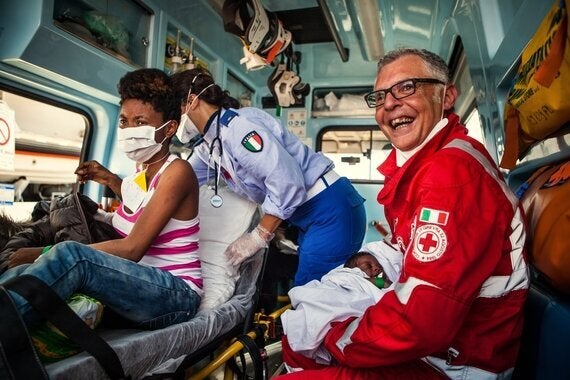
Carlos Spottorno; British Red Cross
The number of people forced to flee violence and conflict today is the highest since World War Two. Many people are dying on dangerous journeys to Europe. Those who do make it experience immense suffering.
Baby Paolo was just 14 days old when he arrived in Messina, Sicily in July 2015. He had spent half his life at sea. He travelled with his mother by boat from Libya and was picked up by the Italian coastguard along with three other boats, 40 miles off the Libyan coast.
West Africa: Ebola outbreak, 2014-2016
•Over 28,000 reported cases of Ebola
•11,310 people died from the Ebola virus
Volunteer: Benjamin Wray (34), Burial Team, Sierra Leone Red Cross
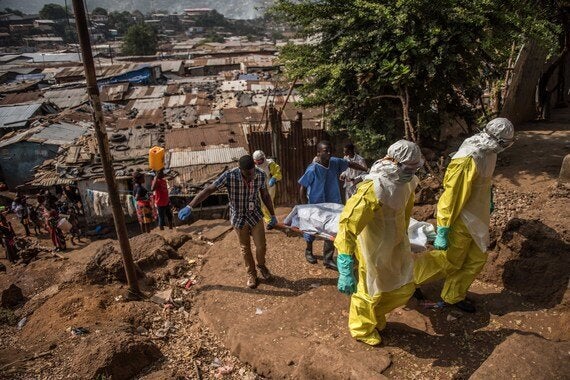
Tommy Trenchard; British Red Cross
The Ebola outbreak, predominately across Guinea, Sierra Leone and Liberia, was the worst outbreak of the disease in history. Courageous volunteers worked to stop the spread of disease through safe and dignified burials. During the outbreak the Red Cross carried out over 42,400 safe and dignified burials across West Africa.
Volunteer Benjamin used to drive public minibuses before he volunteered for the Red Cross burial team in Sierra Leone. Despite the vital importance in safe and dignified burial to halt the spread of Ebola, this role carried huge stigma within his community.
"My friends don't come around anymore because I volunteered for this job, right down to my own family. But I have new friends now. The team leader is like a father. But I worry we will not find jobs after this is over."
Syria Crisis, March 2011 - present
•13.5 million people are in need of aid
•11 million people have fled their homes
•6.5 million people are internally displaced
Field Officer: Monzer Abdo (25), Syrian Arab Red Crescent
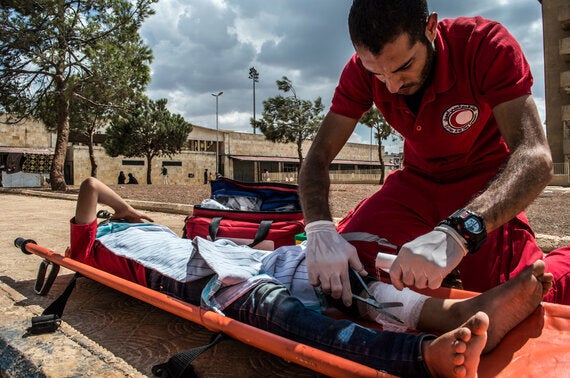
Aleppo Branch Syrian Arab Red Crescent
Humanitarian needs in Syria have reached unprecedented levels.
Monzer is a Field Officer in the first aid team in the Syrian Arab Red Crescent (SARC) Aleppo branch. SARC is one of the very few aid agencies able to cross frontlines in Syria. It helps to bring aid to millions of people every month, often in areas that have not been reached in months. It is the biggest provider of aid in Syria today.
"In my city, the size of the disaster is great, we would almost need to have a paramedic in every home, in order to save lives. I began volunteering in 2010... I found in this work the closest way to save others' lives and alleviate their sufferings."
South Sudan: Civil war, December 2013 - present
•1.6 million people are internally displaced
•Over 600,000 people have fled to neighbouring countries
•7.5 million people are in need of aid
•3.9 million people are food insecure
Volunteer: David Luate, Volunteer Supervisor, South Sudan Red Cross
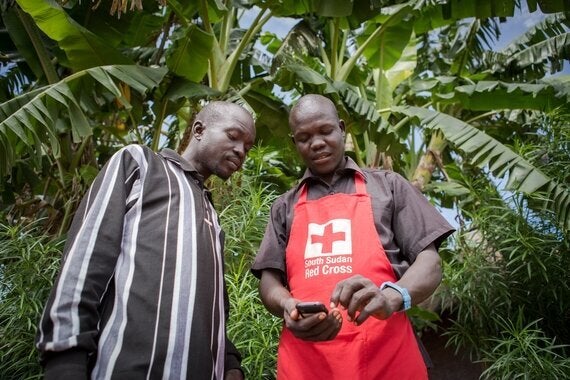
Juozas Cernius; IFRC
The world's newest nation has been engulfed in a vast humanitarian crisis since violence broke out in December 2013. Millions of people have been forced to flee their homes, many of whom have escaped to neighbouring countries. People are in desperate need of the most basic support - food, clean water and shelter.
Volunteer David uses mobile technology to assist the national government's Polio vaccination programme in South Sudan. Mobile phones are increasingly accessible to those affected by crisis and can play an important role in delivering rapid, cost-effective and scalable humanitarian assistance.
Nepal earthquake, April 2015
•9,000 people died
•1 million homes destroyed or damaged
•5.6 million people affected (20% of the population)
Volunteer: Sameer Bajracharya, Search and Rescue, Nepal Red Cross
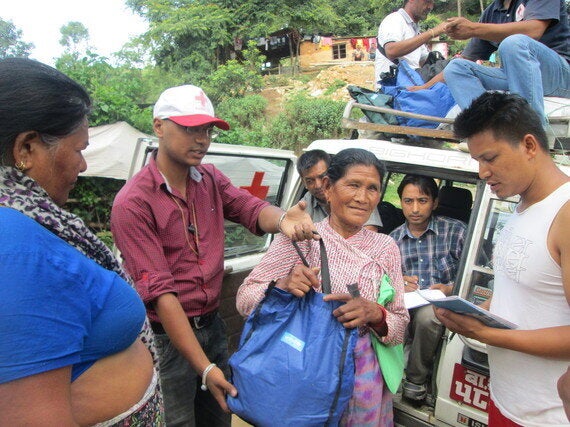
Nepal Red Cross Society
In April and May 2015, Nepal was struck by two huge earthquakes. Over 8,000 staff and volunteers from the Nepal Red Cross carried out evacuations, first aid, and search and rescue operations. Teams also provided relief items and psychological and emotional support to people caught up in the crisis.
Volunteer Sameer self-deployed in the midst of the devastation, donned his Red Cross jacket and helped saved lives. He rescued four people from the rubble in the first 24 hours.
Myanmar: maternal health
•200 maternal deaths for every 100,000 births - one of the highest maternal mortality rates in south-east Asia
•70% of population live in rural areas
•Over 70% of deliveries are home births - 43% are not attended by a skilled health worker
Volunteer: Khin Than, Auxiliary Midwife, Myanmar Red Cross
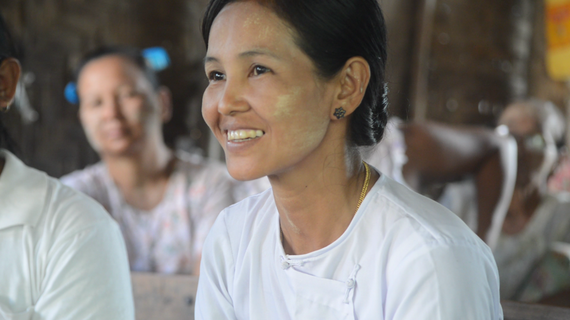
Gregory Rose; British Red Cross
Mothers in Myanmar face limited access to qualified antenatal and postnatal assistance. Many remote villages do not have access to health facilities at all. The long trip to hospital is a large financial burden on families and, for many, facilities are just too far.
Both Khin Than's children were born with the assistance of a volunteer Red Cross midwife and she has since become an auxiliary midwife herself.
"I gave birth to both of them in the dry season which made it easier than if it happened in the rainy season [when access is difficult]. So I wanted to become a (midwife) to help pregnant women in this area because they do not have the facilities."
Khin has now treated 51 women in antenatal and postnatal care; delivering 2 babies herself.
The Red Cross is encouraging expecting mother to go and see trained volunteers, like Khin, as a way of avoiding that cost. It also ensures mothers and babies get the best care possible, without having to travel for miles.
Yemen conflict, March 2015 - present
•21.2 million people are in need of aid
•14.4 million people are food insecure
•6,300 people have been killed
•2.7 million people are internally displaced
•600 hospitals have closed due to attack or lack of supplies
Volunteers with the Yemen Red Crescent Society
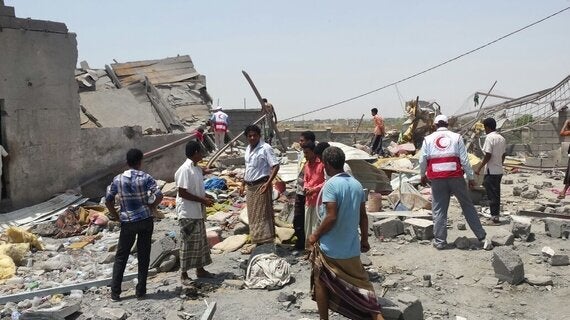
Yemen Red Crescent Society
Yemen is facing one of the worst crises of our time. Since the conflict escalated in March last year, 30 civilians are killed every day in Yemen . Houses and hospitals are bombed, whole areas are cut-off and under siege; people are fleeing for their lives on a daily basis. Over 80% of its 26 million people need assistance in order to survive.
The Yemen Red Crescent society is one of the biggest humanitarian organisations in the country, and one of the very few able to get aid to hard to reach areas. Volunteers are often first on scene after an attack. In the past year, 10 Red Crescent workers have been killed, eight of them volunteers.
To find out how you can support the British Red Cross visit www.redcross.org.uk.
